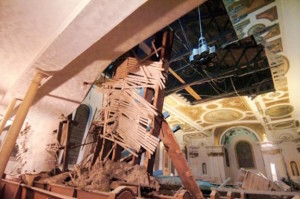On July 3, 1966, the man who had married my mother and father, and baptized me, Father Francis McGinley, lay dying. He had spent his tenure at Saint Thomas Aquinas beautifying the church and setting our school on a secure economic footing. Doctor McGinley was a learned man and a shrewd student of sacred art, so when in his first years he ordered new stained glass windows, it was with an eye to our town, Archbald, and its Irish and other immigrant coal miners, patriotic Americans all.
There was Saint Patrick, his crozier planted upon the green, baptizing an Irishman kneeling before him. There was Our Lady appearing to the children at Fatima, a communist hammer and sickle in the panel below, and a Russian cross in the panel above.
There was Saint Ignatius entreating Saint Francis Xavier to join him, citing the words of Jesus, “What doth it profit a man to gain the whole world?” And in the panel below, Francis, having given himself up to gain the world for Christ, dying upon a distant shore, holding the cross before him.
Two popes appear in the windows too: Pius XII, canonizing the virgin Saint Maria Goretti, and Saint Pius X, giving Holy Communion to a kneeling boy and girl.
In the panel beneath that scene is the only railroad ticket I’ve ever seen in a stained glass window. It reads Ferrovia dello Stato, State Railway – a round trip between Venice and Rome. The humble Pius bought it to attend the conclave after the death of Leo XIII. He never thought he would have to remain in Rome.
The wedding at Cana is there too, with bride and groom watching as Jesus orders the jars to be filled with water. Father McGinley knew what trouble was in the offing, and wished to confirm the Church’s teaching on marriage. The panel above features two golden rings, interlocked, to affirm the holiness and the indissolubility of the union.
It was Father McGinley to whom my mother spoke, when my father was on furlough from his stint in the army, and she was assailed with doubts about chastity. She says that he was gentle, speaking in an exalted way about why God had ordained the sacrament of marriage. She never doubted again.
The same Father McGinley bequeathed, as I’m told, $190,000 to fund our school, the interest to be used for expenses. Back then, the sisters of the Immaculate Heart of Mary staffed the school. We paid no tuition, and we had as many as fifty children in a single class.
But he lay dying, and the beautiful church he left would soon fall victim to the spirit of deletion. How quickly, too! It is a shock to view, next to one another, a photograph of the interior of Saint Thomas’ at his death, and the same interior a mere three years later.

The high altar is gone. The architectural painting that united the walls with the rounded vault of the ceiling has been covered with blank cold white. The large canvases of Saints Peter and Paul, high in the sanctuary to left and right, are gone, leaving the church with the anomaly of ten apostles but not eleven and twelve, and three popes (Blessed Pius IX is on the ceiling, beholding Mary as the Immaculate Conception). But no Saint Peter. It was ugly and stupid.
The church has been restored under the excellent direction of Father Christopher Sahd; but the school is long gone. Father McGinley’s bequest was rifled pretty quickly, once the IHM sisters went, having taken leave of their senses.
I look upon those photographs, and am still astonished; I wonder how embarrassment, if not devotion, failed to restrain the pastors who followed Father McGinley. I knew those men and have always thought well of them. Perhaps there was something in the water, something to turn sensible men into fools or modestly virtuous men into knaves.
I may have discovered that something a few days ago, when my mother and I were combing through old scrapbooks. Among the items was a complete Scranton Times from April 26, 1967, less than a year after Father McGinley’s death. The paper was full of war and the rumors of war, of national tumult – of Robert Kennedy and Martin Luther King, the year before they were assassinated; of Lyndon Johnson and George Romney, and, tucked in an article at the bottom of the front page, accompanied by a handsome photograph of his celebration of the Mass, of Father Charles Curran.
He had just been ousted by Catholic University for public dissent from Catholic teachings regarding sex and marriage.
That article makes for painful reading. Thousands of Catholic students at CUA and Georgetown demonstrated for his reinstatement. Academics across the nation joined in. Humanae Vitae was yet to come, but the teaching, which Paul VI would confirm, was clear.
Here we’d be gratified to read that the Cardinal of Washington, Patrick O’Boyle, came out in support of CUA. O’Boyle later slapped sanctions on priests dissenting from HV, but, according to the article, he joined in the chorus, urging the trustees to uphold academic freedom and to bring Curran back.
One of the men who laid hands upon O’Boyle when he was consecrated bishop was Henry Klonowski, who confirmed my sister and me in 1969. He and O’Boyle were from Scranton, a few miles away. There was a Bishop Klonowski High School in Scranton, now no more.
O’Boyle was theologically orthodox, while socially and liturgically “progressive,” which must have seemed right at the time. It does not seem so now. There is a connection to be drawn between the blank liturgical space where Peter used to be and the blank moral space where Peter’s successor used to be.
Reading that paper, I felt that I stood at the edge of calamity, and that the earth was about to open up beneath.















